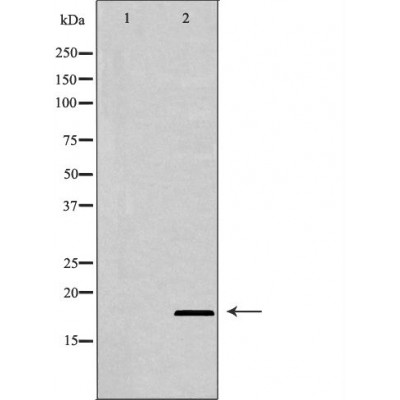BIK Antibody - #DF6958
| Product: | BIK Antibody |
| Catalog: | DF6958 |
| Description: | Rabbit polyclonal antibody to BIK |
| Application: | WB IHC IF/ICC |
| Reactivity: | Human |
| Mol.Wt.: | 18kDa; 18kD(Calculated). |
| Uniprot: | Q13323 |
| RRID: | AB_2838914 |
Related Downloads
Protocols
Product Info
*The optimal dilutions should be determined by the end user. For optimal experimental results, antibody reuse is not recommended.
*Tips:
WB: For western blot detection of denatured protein samples. IHC: For immunohistochemical detection of paraffin sections (IHC-p) or frozen sections (IHC-f) of tissue samples. IF/ICC: For immunofluorescence detection of cell samples. ELISA(peptide): For ELISA detection of antigenic peptide.
Cite Format: Affinity Biosciences Cat# DF6958, RRID:AB_2838914.
Fold/Unfold
Apoptosis inducer NBK; BBC1; Bcl-2-interacting killer; BCL2 interacting killer; bhikhari; BIK; Bik-like killer protein; BIK_HUMAN; BIP 1; BiP1; BP 4; BP4; cb 60; NBK;
Immunogens
A synthesized peptide derived from human BIK, corresponding to a region within N-terminal amino acids.
- Q13323 BIK_HUMAN:
- Protein BLAST With
- NCBI/
- ExPASy/
- Uniprot
MSEVRPLSRDILMETLLYEQLLEPPTMEVLGMTDSEEDLDPMEDFDSLECMEGSDALALRLACIGDEMDVSLRAPRLAQLSEVAMHSLGLAFIYDQTEDIRDVLRSFMDGFTTLKENIMRFWRSPNPGSWVSCEQVLLALLLLLALLLPLLSGGLHLLLK
Research Backgrounds
Accelerates programmed cell death. Association to the apoptosis repressors Bcl-X(L), BHRF1, Bcl-2 or its adenovirus homolog E1B 19k protein suppresses this death-promoting activity. Does not interact with BAX.
Proteolytically cleaved by RHBDL4/RHBDD1. RHBDL4/RHBDD1-induced cleavage is a necessary step prior its degradation by the proteosome-dependent mechanism.
Endomembrane system>Single-pass membrane protein. Mitochondrion membrane>Single-pass membrane protein.
Note: Around the nuclear envelope, and in cytoplasmic membranes.
Intact BH3 motif is required by BIK, BID, BAK, BAD and BAX for their pro-apoptotic activity and for their interaction with anti-apoptotic members of the Bcl-2 family.
Research Fields
· Human Diseases > Drug resistance: Antineoplastic > Endocrine resistance.
Restrictive clause
Affinity Biosciences tests all products strictly. Citations are provided as a resource for additional applications that have not been validated by Affinity Biosciences. Please choose the appropriate format for each application and consult Materials and Methods sections for additional details about the use of any product in these publications.
For Research Use Only.
Not for use in diagnostic or therapeutic procedures. Not for resale. Not for distribution without written consent. Affinity Biosciences will not be held responsible for patent infringement or other violations that may occur with the use of our products. Affinity Biosciences, Affinity Biosciences Logo and all other trademarks are the property of Affinity Biosciences LTD.
